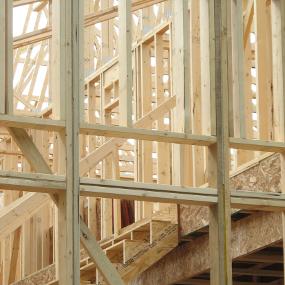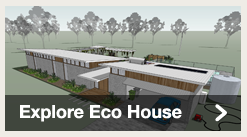Build it Back Greenbushfires
Timber
 Timber
is probably the most commonly used building material there is. It
is strong, flexible, readily available and providing it is sourced
properly, is a renewable resource. It is an easy material to work
with and requires relatively basic skills, making it ideal for
owner-builders.
Timber
is probably the most commonly used building material there is. It
is strong, flexible, readily available and providing it is sourced
properly, is a renewable resource. It is an easy material to work
with and requires relatively basic skills, making it ideal for
owner-builders.
Wood has a high strength for its weight and can be used to support high vertical loads, such as in main roof support pillars. With correct engineering it can support high loads in horizontal spans, such as when used for roofing trusses. Timber is commonly used for framing, trusses, internal and external cladding (weatherboards).
Timbers come in both softwoods (radiata pine is an example) and hardwoods (redgum, for example), although the names can be a bit misleading, as some softwoods are harder than many hardwoods and visa versa.
Most timbers have little thermal mass. Softer, lighter timbers have no usable thermal mass, but are reasonable insulators. High density woods have moderate thermal mass but short thermal lag times. Timber homes should be well insulated, and additional thermal mass added if so required, such as the use of concrete floors. Where floors are wood only, they should be insulated underneath.
When buying timber, you need to be careful of where it is sourced. Ideally, you should buy reclaimed/recycled timber if possible. There are a number of suppliers who have a range of high grade timbers which have been reclaimed from demolished buildings and structures.
If you need to buy new timber, look for plantation timbers, although not all woods are available plantation grown. If you have to buy forest-sourced timber look for sustainably certified timbers, such as Forestry Stewardship Council (FSC) certified. This way you are most likely buying a product from well-managed forests.
Wood is often considered a CO2 neutral or even CO2 positive material, as the growth of trees removes CO2 from the atmosphere and locks it up in wood. However, wood, like all natural materials, eventually rots, even if it takes a few hundred years, so the carbon is eventually released, although some of it ends up locked up in soil, so trees can be considered CO2 removers to some degree.
Some timbers are better suited to outdoor and building use than others. Most pines are not ideal for outdoor use as they are subject to rot and insect attack. Cypress pine has a natural resistance to attack and can be used unfinished in fences and similar applications. However, timber should be protected from the natural environment by paint, natural oils or varnishes.
There are many wood-based materials available, such as engineered wooden beams, laminated boards (plywood) and fibreboards such as MDF (medium density fibreboard). These are usually available in low or zero VOC (volatile organic compound) versions which are less toxic than the regular varieties.
As you would expect most wood is a highly combustible building material so may not be suitable for high risk bushfire areas. For example a wide range of Australian hardwood timbers may be used in low to medium bushfire risk areas, becoming more restrictive in species with higher Bushfire Attack Level (BAL) zones. Only a selected number of timber species (listed in AS 3959-2009) will meet higher bushfire requirements and these are are: Blackbutt, Spotted Gum, Silvertop Ash, Kwila (Merbau), Red Ironbark, River Red Gum; Turpentine.
Before building check with your designer, builder or local council building surveyor to see what bushfire protection building standards and BAL applies to your home.
Suppliers
Australian Recycled Timber - www.australianrecycledtimber.com
Ph. 03 9359 0300
Radial Timbers - www.radialtimbers.com.au
Ph. 03 9768 2100
Shiver Me Timbers - www.shivermetimbers.com.au
Ph. 03 9317 7122
Timberzoo - www.timberzoo.com.au
Ph. 03 5248 1223
Urban Salvage - www.urbansalvage.com.au
Ph. 03 9391 0466
- More Info
- > Building Commission
- > Ecospecifier
Listed suppliers are a guide and are not endorsed by Green Cross Australia or the Alternative Technology Association.


